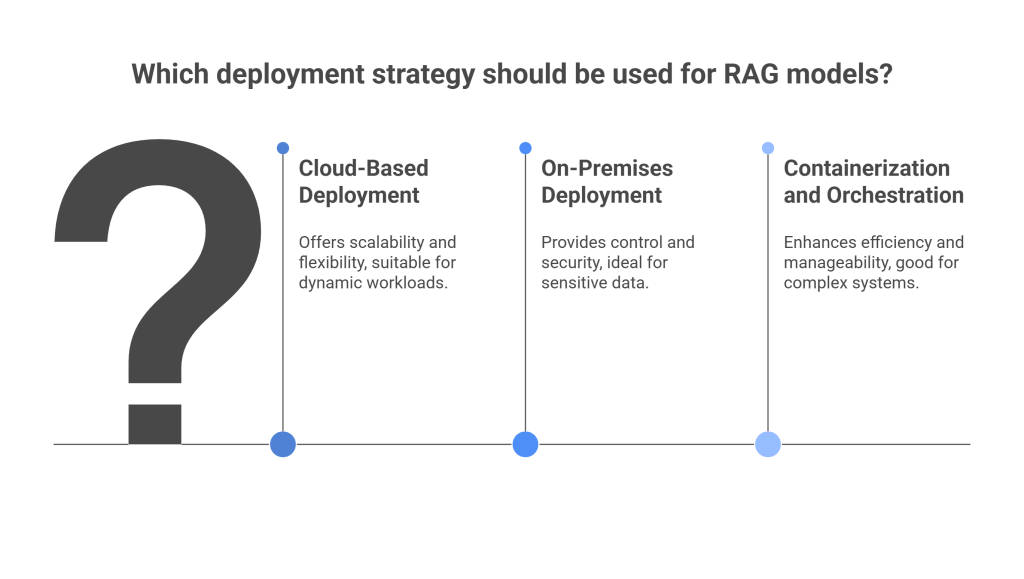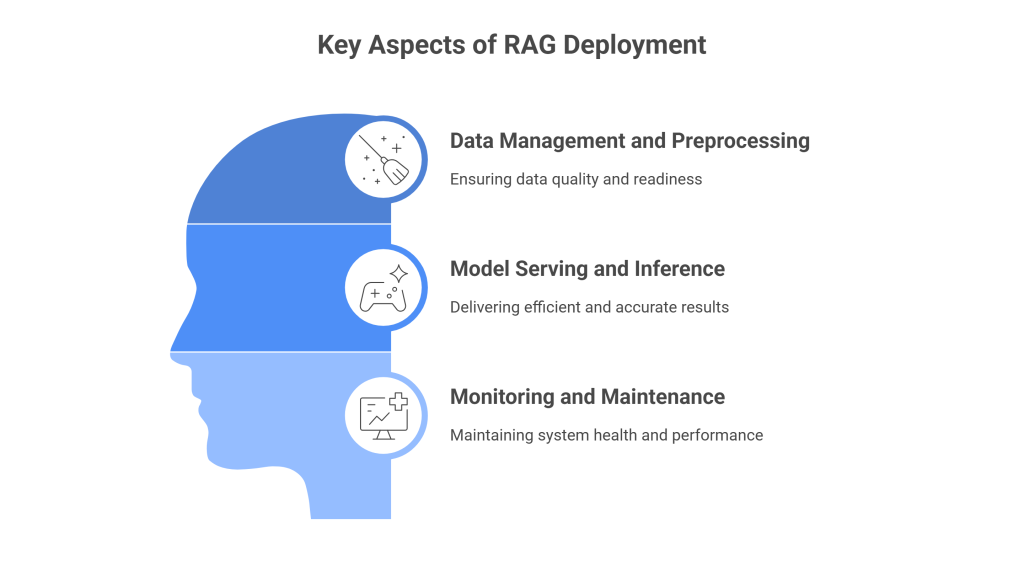The RAG architecture represents a major step forward in language model design. By combining retrieval from external knowledge sources with traditional generation, it bridges the gap between static training data and real-world information needs. When paired with effective RAG production deployment strategies, this approach enables models to dynamically access, update, and apply relevant knowledge, overcoming the long-standing limitations of conventional models that rely solely on a fixed corpus.
The RAG architecture consists of three main components: a retriever, an encoder, and a generator. The retriever component searches through a vast knowledge base, such as Wikipedia or domain-specific databases, to find relevant information related to the input query or context. The encoder then processes the retrieved knowledge and the original input to create a rich representation. Finally, the generator component uses this enhanced representation to generate the desired output, be it a natural language response, a summary, or other language-based task.
Advantages of RAG for Language Model Deployment
Deploying language models with RAG architecture offers several advantages over traditional approaches. Firstly, it allows the model to leverage external knowledge sources, ensuring that the generated outputs are well-informed and up-to-date, even for topics not covered in the original training data. This is particularly valuable in domains where knowledge evolves rapidly or where specialized expertise is required.
Additionally, RAG models can be more sample-efficient, as they can leverage existing knowledge bases rather than relying solely on the limited training data available for a specific task or domain. This can improve performance, especially in low-resource settings or tasks with limited labeled data.
Challenges of Deploying RAG in Production
While RAG offers compelling benefits, deploying these models in production environments presents unique challenges. One significant challenge is the efficient management and retrieval of large knowledge bases. This process can be computationally intensive, requiring specialized indexing and retrieval strategies to ensure optimal performance. Further, guaranteeing the quality and reliability of the external knowledge sources is another challenge, as they may contain biases, inconsistencies, or inaccuracies that could propagate to the model’s outputs.
Deployment Strategies for RAG Models

Cloud-Based Deployment
One of the most popular deployment strategies for RAG models is leveraging cloud computing resources. Cloud platforms, especially those like Amazon Web Services (AWS), Google Cloud Platform (GCP), and Microsoft Azure, offer scalable and flexible infrastructure to address the computational demands of RAG models. By using cloud-based services, organizations can use virtually unlimited computing power, storage, and networking resources, enabling them to scale their RAG deployments seamlessly as demand increases.
Scalability and elasticity are key considerations when deploying RAG models on the cloud. These models often require significant computational resources for tasks like retrieving and processing large knowledge bases, encoding inputs, and generating outputs. Cloud providers offer auto-scaling capabilities that allow organizations to dynamically adjust their resource allocation based on workload fluctuations, assuring optimal performance and cost efficiency.
Cost management and optimization are crucial when deploying RAG models in the cloud. Organizations can leverage various cost optimization strategies, such as spot instances, reserved instances, and right-sizing resources, to minimize overall operational costs while maintaining performance requirements.
On-Premises Deployment
For organizations with uncompromising data privacy and security requirements or existing on-premises infrastructure, deploying RAG models locally may be a more suitable option. On-premises deployment involves setting up and managing the necessary hardware and software infrastructure within the organization’s data centers or private clouds.
Determining the appropriate hardware requirements and infrastructure setup is crucial for successful on-premises deployment. RAG models often require powerful GPUs or TPUs for efficient inference and training and high-performance storage and networking solutions to handle large knowledge bases and data processing. Proper capacity planning and load-balancing strategies are essential to ensure optimal performance and resource utilization.
Data privacy and security considerations are vital drivers for on-premises deployment. Organizations in highly regulated industries or those overseeing sensitive data may prefer to keep their data and models within their controlled environments, minimizing the risk of data breaches or unauthorized access.
Containerization and Orchestration
Regardless of the deployment environment (cloud or on-premises), containerization and orchestration technologies can significantly simplify the deployment and management of RAG models. Containerization involves packaging the RAG model and its dependencies and configurations into a lightweight, portable container image. This approach ensures consistent and reproducible deployments across diverse environments, diminishing the risk of configuration drift or environment-specific issues.
Practical Considerations for RAG Deployment

Data Management and Preprocessing
Effective data management and preprocessing are critical for successful RAG deployments. One key task is sourcing and curating relevant knowledge sources. Organizations may need to identify and integrate multiple knowledge bases, such as Wikipedia, domain-specific databases, or proprietary knowledge repositories, to ensure comprehensive coverage of the required information.
Data cleaning and preprocessing pipelines are essential to ensure the quality and consistency of the knowledge sources. This may involve deduplication, normalization, and entity resolution to eliminate redundancies and inconsistencies across different data sources. Additionally, techniques like text cleaning, tokenization, and feature extraction may be required to prepare the data for efficient indexing and retrieval.
Indexing and retrieval strategies play a crucial role in the performance and efficiency of RAG models. Suitable indexing techniques, such as inverted indexes or specialized data structures like KD-trees, must enable fast and accurate retrieval of relevant knowledge from large knowledge bases. Effective retrieval strategies, such as approximate nearest neighbor search or dense vector indexing, can significantly improve the speed and accuracy of knowledge retrieval.
Model Serving and Inference
Deploying RAG models in production environments requires robust model serving and inference capabilities. Organizations may leverage existing model serving frameworks and tools, such as TensorFlow Serving, Triton Inference Server, or proprietary solutions, to serve their RAG models and handle real-time inference requests efficiently.
Batching and caching techniques can optimize model performance and reduce latency. The model can leverage parallelization and achieve higher throughput by batching multiple inference requests together. Caching strategies, such as caching intermediate results or frequently accessed knowledge chunks, can improve response times and reduce computational overhead.
The choice between real-time inference and offline generation depends on the specific use case and requirements. Real-time inference is suitable for applications that require immediate responses, such as chatbots or virtual assistants, where the model generates outputs on the fly based on user input. Offline generation may be preferred for batch processing tasks, such as document summarization or knowledge base construction, where the outputs can be precomputed and stored for later retrieval.
Monitoring and Maintenance
Implementing robust logging and monitoring infrastructure is crucial for effectively maintaining and troubleshooting RAG deployments. Organizations should establish comprehensive logging mechanisms to capture relevant information, such as input data, retrieved knowledge, generated outputs, and performance metrics. This logged data can be analyzed to identify issues, track model performance, and guide optimization efforts.
Performance monitoring and optimization are ongoing processes in RAG deployments. Organizations should regularly scrutinize key performance indicators (KPIs), such as latency, throughput, and accuracy, and implement strategies to optimize model performance. This may involve techniques like model quantization, model distillation, or architecture modifications to improve efficiency without sacrificing accuracy.
Finally, model retraining and update strategies are essential to ensure RAG models remain up-to-date and aligned with evolving knowledge sources and user requirements. Organizations should establish processes for periodic model retraining, incorporating new data and knowledge sources and mechanisms for seamless model updates in production environments.
Advanced Topics and Future Directions
RAG for Multilingual and Cross-Lingual Applications
As language models gain traction in diverse global markets, deploying RAG models for multilingual and cross-lingual applications has become increasingly important. However, this presents unique challenges, such as handling varying linguistic structures, resolving ambiguities, and ensuring cultural and contextual appropriateness across languages.
One approach is to develop separate RAG models for each target language, leveraging language-specific knowledge bases and training data. Alternatively, transfer learning and multi-task fine-tuning techniques can adapt a single, multilingual RAG model to different languages, potentially reducing development and deployment costs.
RAG with Multimodal Data
While RAG models primarily focus on textual data, there is growing interest in integrating multimodal data sources, such as images, videos, and structured data (e.g., tables and graphs). This opens up new possibilities for applications like visual question answering, multimedia summarization, and multimodal knowledge base construction.
Incorporating multimodal data into RAG models requires specialized architectures and techniques for multimodal retrieval and generation. This may involve integrating vision and language models, developing multimodal knowledge representations, and enabling cross-modal reasoning and generation capabilities within the RAG framework.
Privacy-Preserving and Secure RAG Deployment
As RAG models handle sensitive data and generate outputs that can potentially reveal private or confidential information, privacy-preserving and secure deployment strategies are of utmost importance. Differential privacy techniques can inject controlled noise into the model’s outputs, ensuring that individual data points cannot be easily inferred or reconstructed.
Additionally, secure enclaves and trusted execution environments can be leveraged to isolate and protect sensitive computations and data within RAG deployments. These hardware-based security solutions can safeguard against various hazards, such as unauthorized entry, data breaches, and side-channel incursions.
Final Thoughts
Deploying RAG models in production environments involves addressing challenges related to deployment strategies, data management, model serving, monitoring, and advanced topics like multilinguality and privacy preservation. By leveraging cloud resources, containerization, and efficient retrieval techniques, organizations can unlock the power of RAG models to generate well-informed and up-to-date outputs across various domains.
Future Outlook and Research Opportunities
As RAG models evolve, future research will likely focus on improving multimodal integration, developing more robust and efficient retrieval mechanisms, and exploring novel architectures and training paradigms. Additionally, services like Protecto can play a vital role in securing RAG deployments against potential threats and ensuring the privacy and reliability of these advanced language models.




